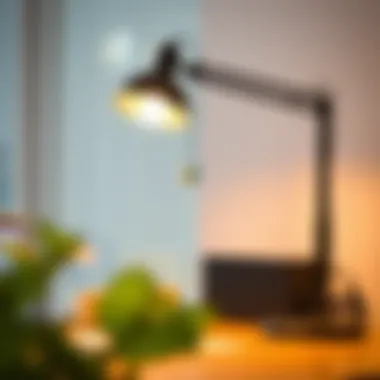Quality Desk Lamps: Selecting the Best Lighting Options


Intro
When it comes to creating a productive workspace, the role of effective lighting cannot be overstated. Desk lamps are not simply utilitarian objects; they can significantly influence mood, focus, and overall well-being. Understanding how to choose the right desk lamp involves navigating a myriad of options, from design aesthetics to functional features. This guide is tailored for homeowners, designers, retailers, carpenters, and DIY enthusiasts, equipping you with the knowledge necessary to make informed lighting choices that align with both style and efficiency.
Let’s delve into what makes a desk lamp not just good, but the best fit for your workspace. A desk lamp should serve not only as a source of illumination but also elevate your space's aesthetic, and considering various design trends and materials is a great starting point.
Understanding the Importance of Quality Desk Lamps
In today's fast-paced world, the significance of a well-lit workspace cannot be overstated. Desk lamps are not just a source of illumination; they play a pivotal role in enhancing productivity and overall well-being. The right lighting can make a world of difference, sharpening focus, reducing eye strain, and creating an atmosphere conducive to both work and creativity.
Enhancing Workspace Productivity
Lighting is often an underestimated element in workspace design. A high-quality desk lamp can transform a mundane area into a vibrant productivity zone. With appropriate lighting, the brain receives signals that foster alertness and motivation. Picture this: you're working late, the sun has dipped below the horizon, and the flickering fluorescent lights in the office leave you yearning for a gentle, warm glow. Enter a quality desk lamp, adjustable to cast just the right amount of light on your task without overwhelming your senses.
Some key benefits of using an effective desk lamp include:
- Reduced Eye Strain: Quality desk lamps offer better light quality, leading to less squinting and discomfort while reading or typing.
- Mood Enhancement: Bright light can improve one's mood and energy levels, while warmer tones can promote a sense of relaxation. This balance can stimulate creativity.
- Fostering Focus: Task lighting that is directed and bright enough for detail work encourages sustained concentration, making tasks seem less daunting.
When selecting a desk lamp, look for adjustability features, brightness levels, and color temperature settings. This allows you to customize the lighting experience to suit your task or mood.
Health Benefits of Proper Lighting
The impact of lighting on health is both profound and multifaceted. Inadequate lighting can lead to a host of problems, including headaches, fatigue, and poor posture as individuals lean closer to their screens or tasks.
Good lighting design, particularly with quality desk lamps, can improve:
- Circadian Rhythms: Exposure to the correct light temperature during working hours supports the body’s internal clock. Transitioning to warmer light in the evening can signal it’s time to unwind, promoting better sleep quality.
- Mental Clarity: Studies have shown that spaces lit with quality desk lamps lead to increased clarity of thought and decision-making capacity. A well-lit environment can support brain function, making tasks feel less overwhelming.
- Visual Comfort: Lighting that’s properly diffused can keep your work area looking sleek. Information should be easy to read, free from glare and shadows, substantially improving your overall experience and productivity.
"Lighting is not just the absence of darkness, but a key ingredient to a harmonious workspace."
Key Features of Quality Desk Lamps
Quality desk lamps play an essential role in shaping a productive workspace. Picking the right lamp involves more than just aesthetics. The key features of these lamps directly influence your comfort and efficiency. In this section, we explore crucial aspects such as adjustability, light quality, and energy efficiency, which guide homeowners, designers, and DIYers in making informed choices.
Adjustability and Flexibility
In a world of constant change, being able to tweak your desk lamp not just helps you light your workspace but also addresses the unique needs you might have on any given day. Adjustability refers to the lamp's ability to change direction or height. Consider the task at hand: is it reading, sketching, or perhaps assembling small parts? Different tasks demand different lighting angles.
- Tilt and Swivel: Look for lamps with heads that can tilt and swivel, allowing you to direct light precisely where it's needed. This is especially important for artists or anyone working on detailed projects.
- Height Options: Whether you prefer a tall standing lamp or a compact desk model, height adjustability ensures that the light accommodates your workspace efficiently.
- Arm Length: Models with extendable arms provide flexibility in placement, making them a great fit for small or irregularly shaped desks. If your desk is pushed against a wall, an adjustable arm can showcase its versatility.
Light Quality and Temperature
The color and intensity of light significantly affect our ability to focus and maintain energy levels. A desk lamp with high-quality lighting allows for a better ambiance, directly impacting productivity. Furthermore, not all lights are created equal when it comes to color temperature — a key factor in lighting design.
- Color Temperature: Measured in Kelvins (K), color temperature influences mood and comfort. For instance:
- Color Rendering Index (CRI): This metric indicates how accurately colors appear under the light. Aim for lamps with a CRI of 90 or higher to ensure visual tasks are performed accurately.
- Warm White (2700K-3000K): Great for cozy reading spaces, emitting a yellowish hue similar to incandescent bulbs.
- Cool White (4000K-5000K): Closer to daylight, this range enhances alertness and concentration, ideal for workspaces.
Lighting is critical in executing tasks efficiently. Poor lighting can lead to eye strain and diminished performance.


Energy Efficiency Considerations
In today’s eco-conscious climate, energy efficiency is more than just a trend; it's a necessity. Quality desk lamps can significantly contribute to reducing energy consumption in workspaces.
- LED Technology: Selecting a lamp that uses LED technology is an excellent way to save on electricity bills. LEDs consume up to 80% less energy than traditional incandescent bulbs and have extended lifespans.
- Smart Features: Modern innovations often incorporate smart features that allow you to control the light brightness or even schedule on/of timers via your smartphone, thereby reducing unnecessary energy use.
- Energy Star Rating: Always check for the Energy Star label, which signifies that the product meets energy efficiency guidelines set by the Environmental Protection Agency. Choosing a lamp that has this certification ensures that while you’re lighting up your workspace effectively, you are also being kind to the planet.
By focusing on these key features, you can choose a desk lamp that not only enhances your workspace but also complements your daily activities, effectively combining form with function.
Types of Desk Lamps
When it comes to choosing the right lighting for a workspace, understanding the different types of desk lamps is crucial. Each type of lamp serves its own purpose, catering to distinct needs in terms of lighting quality, aesthetics, and functionality. The right lamp not only illuminates your desk but also affects your overall productivity and comfort. Let’s delve into the various kinds of desk lamps that are available on the market today.
Traditional Desk Lamps
Traditional desk lamps combine classic design aesthetics with functional features. These lamps often have adjustable arms and shades, allowing users to direct light precisely where it's needed. What stands out about traditional desk lamps is their versatility.
- Design: Many traditional lamps boast a timeless look, making them suitable for various interiors. From vintage brass to sleek black finishes, there’s a design for every taste.
- Light Bulb Options: These lamps typically use incandescent or halogen bulbs, which provide warm light that’s easy on the eyes, especially for long hours of reading or studying.
- Cost-Effective: Generally, traditional lamps can be more affordable than modern alternatives, appealing to those who seek quality on a budget.
LED Desk Lamps
LED desk lamps have gained popularity in recent years due to their energy efficiency and long lifespan. They provide a bright, focused light that is adjustable, catering to various activities from detailed work to casual reading.
- Energy Saving: These lamps consume significantly less power than traditional bulbs, making them an eco-friendly option.
- Adjustable Brightness: Many models come equipped with features like dimming capabilities or color temperature adjustments, allowing users to customize their lighting experience according to the task.
- Design Flexibility: LED lamps come in a range of designs from ultra-slim to more ornate models, accommodating diverse personal styles.
Smart Desk Lamps
As technology continues to revolutionize home and office spaces, smart desk lamps are becoming increasingly prevalent. These lamps incorporate innovative technology, allowing them to be controlled remotely or via voice commands.
- Integration with Other Smart Devices: They can often be synchronized with smart home systems, offering seamless control over lighting alongside other devices like smart thermostats or speakers.
- Dynamic Features: Smart lamps can provide features like scheduling, sleep modes, and even integration with apps to track energy usage.
- Color Customization: Many smart desk lamps allow for color changes, which can help set the mood or provide various lighting effects for different tasks.
Architectural Task Lamps
Architectural task lamps are specifically designed for creating precise lighting in work settings, often used by designers, architects, and artists. They combine form and function in a way that emphasizes both aesthetics and performance.
- Precision Lighting: These lamps shine direct light onto surfaces, ideal for detailed work requiring focus.
- Design Influence: Typically characterized by sleek designs, these lamps can act as a statement piece in an office or studio setup.
- Versatility in Use: Not limited to desks, these lamps can also be used in galleries or workspaces to highlight specific pieces of art or projects.
Design Considerations for Desk Lamps
Choosing a desk lamp isn't simply about ensuring you have light on your workspace; it’s about thoughtful design that complements both function and aesthetics. The desk lamp's design plays a pivotal role not only in the overall workspace environment but also as an extension of personal style. Key elements of design considerations include the aesthetic appeal, material choices, and the size relative to the furniture. Each aspect holds its own significance and impacts how well a desk lamp serves its purpose while enhancing the workspace.
Aesthetic Appeal in Office Spaces
A desk lamp often stands as a focal point in an office—one that reflects the personality of its user. When selecting a lamp, the visual elements are paramount. A lamp should harmonize with the surrounding decor, transforming the workspace into a reflection of one's taste and atmosphere. Whether you prefer a sleek, modern fixture or a vintage piece, choosing a lamp that resonates with your vision can elevate the mood of the room.
For instance, a minimalist design can bring a sense of calmness to a hectic environment, while a bold and quirky lamp can make an inspiring statement about creativity. The finishes, colors, and shapes all contribute to the overall impression, so one must not overlook how these elements interact with other office furnishings.
"The right lamp can be like the cherry on top of an already great workspace. It’s not just about lighting; it’s about creating an experience."
Material Choices and Their Impact
The materials used in a desk lamp can greatly influence its durability, maintenance, and aesthetic quality. Common materials include metals, plastics, glass, and wood. Each comes with its own advantages.


- Metal lamps tend to provide sturdiness and a sleek appearance, often associated with modern designs.
- Plastic offers versatility at a lower price point, making it a popular choice for various styles.
- Glass can add elegance but requires care to avoid breakage.
- Wooden lamps, on the other hand, bring a warm, organic feel that suits rustic or natural themes.
Beyond aesthetics, one should also consider how cared-for materials match an individual’s lifestyle. For instance, wood may be preferred by someone who appreciates sustainability, while metal might appeal to those seeking a contemporary edge.
Size and Proportions in Relation to Furniture
Another crucial factor in design considerations is the lamp's size and proportions. A traveling lamp must not only fit comfortably on the desk but also provide appropriate lighting without overwhelming the workspace.
- An oversized lamp in a small area may visually dominate and create an unbalanced look.
- Conversely, a too-small lamp on a sizable desk may appear lost and ineffective, both functionally and aesthetically.
Assessing the proportions against other furniture is essential: how does the lamp height relate to your eye level? Is it adjustable to cast light precisely where you need it? Placing the lamp at the right height affects not simply the illumination but also your posture and well-being.
When contemplating a new desk lamp, let your design choices speak to your needs and preferences while ensuring that these elements ground the lamp in its environment. This careful consideration can lead to a more productive atmosphere and create a cohesive, inviting workspace.
Choosing the Right Desk Lamp for Your Needs
Selecting the appropriate desk lamp is not just about lighting; it’s about transforming the very essence of your workspace. An ideal lamp provides adequate brightness to reduce eye strain while enhancing the overall aesthetics of the room. If you're looking to improve focus while working or simply want a cozy vibe in your reading nook, the right desk lamp can make a world of difference. Without proper illumination, even the best-designed workspace can feel dreary and uninviting, ultimately stifling productivity.
Assessing Your Workspace Environment
Before you make any decisions, it’s crucial to evaluate the specifics of your workspace. Ask yourself the following:
- Size of the Space: Is your workspace cramped and cozy, or spacious and airy? A large lamp might overwhelm a tiny desk, while a small one may get lost in a big room.
- Existing Light Sources: How much natural light does the area get during the day? If your desk sits near a window, you might opt for a softer lamp that complements daylight. Conversely, in dim settings, a more powerful light source is necessary to brighten your tasks.
- Surface Reflection: Consider the colors of your walls and surfaces. Dark wood may absorb light, needing a stronger lamp, whereas lighter surfaces can reflect and distribute light more evenly.
This assessment ensures you don't just buy any lamp off the shelf. Each lamp should fit the purpose it serves, ensuring effectiveness and style.
Personal Lighting Preferences
While technical specifications do matter, personal preferences in terms of lighting cannot be ignored. After all, what feels right to one person might be glaring and uncomfortable to another. Here are some factors to consider when evaluating your taste in lighting:
- Warm vs. Cool Light: Do you prefer the cozy ambiance of warm yellow light, or does the clean clarity of cool white work better for your tasks? Warm light creates a welcoming atmosphere, while cool light promotes alertness.
- Brightness Levels: Some people prefer dim lighting for intricate tasks like drawing or writing, while others need bright, focused light for reading or detailed work. Opt for adjustable lamps where you can easily change brightness.
- Color Rendering: How colors appear is crucial, especially for tasks that require color accuracy. Higher CRI (Color Rendering Index) lamps are beneficial for artists or designers who rely on color fidelity.
Choosing based on your personal taste offers more than just physical benefits; it also contributes to your mental well-being in your workspace.
"A lamp is not just a source of light; it's an expression of who you are and how you work."
By considering both your environment and your individual needs, you can find a desk lamp that doesn’t just light your space but also supports your productivity and creativity. Curious about more tips? Check out Wikipedia for insights on lighting fundamentals!
Caring for Your Desk Lamp
Caring for your desk lamp is not merely an afterthought; it's an essential practice that ensures you get the most from your investment in quality lighting. Desk lamps serve functional and aesthetic purposes, providing illumination for work while also enhancing the overall atmosphere of a workspace. Neglecting care can lead to diminished performance and unsightly deterioration. Therefore, proper maintenance and cleaning techniques could extend the life of your desk lamp significantly.
Maintenance Tips for Longevity
To maximize the lifespan of your desk lamp, consider these key maintenance tips:
- Avoid Overheating: Ensure your lamp doesn't operate in enclosed spaces and that it has proper ventilation. Heat can wear components out faster than you might expect.
- Change Bulbs as Needed: Using the appropriate wattage for your lamp is essential. Overly powerful bulbs can lead to early burnout and potential hazards.
- Check Electrical Components: Periodically inspect the cord and plug for wear and tear. Any fraying or exposed wires should be addressed immediately to avoid safety risks.
- Tighten Connections: Loosened bulbs or fixtures can cause flickering and inconsistent lighting. A quick tighten can often fix these issues.
- Store Properly: When not in use, keep the lamp out of dust, and avoid placing heavy items on its surface.
By adhering to these tips, you can ensure that your desk lamp not only looks great but also functions effectively for years.
Cleaning Techniques to Maintain Clarity


Keeping your desk lamp clean is vital, not only for clarity of light but also for its overall appearance and functionality. Here are some effective cleaning techniques:
- Dust Regularly: Use a microfiber cloth or a soft brush to dust off the lampshade and base weekly. Accumulated dust can create shadows and impede light.
- Use Gentle Cleaners: For deeper cleaning, mix a mild soap with lukewarm water. Dampen your cloth with the solution, then wipe down all surfaces, focusing on any stains or residues that might have built up.
- Avoid Abrasives: Steer clear of harsh chemicals and abrasive materials that can scratch or dull the finish, especially on decorative elements.
- Lampshade Care: If your lamp has a fabric shade, consider spot-cleaning with appropriate fabric cleaner, or using a lint roller for minor spots and spills.
- Clear the Light Bulb: A clean bulb can significantly improve brightness. Use a soft, dry cloth to wipe it regularly, which also helps to prevent heat build-up.
Remember: Regular care is essential not only for aesthetics but also to maintain the functionality and safety of your desk lamp.
Incorporating these practices into a routine maintenance schedule ensures your desk lamp remains a beacon of light, guiding your productivity and enhancing your workspace effectively.
Current Trends in Desk Lamp Designs
In the realm of desk lighting, much has changed over the years. Quality desk lamps have evolved from mere functional tools to integral elements of workplace aesthetics and ergonomics. Staying abreast of the latest trends in desk lamp designs can help homeowners, designers, and DIY enthusiasts choose lamps that not only illuminate but also enhance the overall workspace. It's about combining form with function, ensuring that the selection suits both personal tastes and the demands of the environment.
Minimalism and Functionality
Minimalism has become a hallmark of modern design, and desk lamps are no exception. A minimalist lamp often boasts simple lines, a soft color palette, and a sleek silhouette that effectively reduces visual clutter in a workspace. These lamps emit light without drawing attention away from the tasks at hand, allowing users to maintain focus.
- Benefits of Minimalism:
- Enhances the sense of space, making small offices feel larger.
- Easy to match with various decor styles, from contemporary to rustic.
An example of a minimalistic lamp could be one with a flat disk base and a slender adjustable arm that allows for easy positioning. Designers put thought into the functionality of these lamps as well, ensuring that even a little piece can have a big impact on performance.
"A good desk lamp shouldn’t shout for attention; it should simply be there when you need it."
Functionality does not take a backseat, either. Today's lamps often feature adjustable brightness settings and color temperatures to cater to different tasks. An architect looking to draft detailed plans may prefer a cooler light, while someone reading a novel could opt for a warmer hue.
Sustainable Lighting Solutions
As environmentally conscious choices gain traction, sustainable lighting solutions are increasingly making waves. Desk lamps now incorporate eco-friendly materials, energy-efficient bulbs, and production processes that align with green principles. This trend supports the global movement towards reducing carbon footprints and embracing renewable resources.
- Key Aspects of Sustainable Solutions:
- Utilization of recycled materials in lamp construction.
- Incorporation of LED technology to minimize energy consumption.
When selecting a sustainable desk lamp, buyers may find options made from bamboo or recycled metals, ensuring that style doesn’t compromise ethical considerations.
Moreover, many contemporary lamps come equipped with features such as timers and sensors that automatically adjust lighting based on the time of day or natural light conditions. This not only saves energy but also promotes healthier lighting strategies that adapt to our daily rhythms.
The Future of Desk Lighting
As the pace of life accelerates and our reliance on technology grows, the future of desk lighting is shaping up to be a blend of functionality and innovation. The once static conception of desk lamps is evolving, with greater emphasis on adapting to the user’s needs and environment. In this section, we'll explore why it's imperative to understand these advancements and how they can benefit various aspects of work and leisure.
Integrating Technology into Design
The introduction of smart technologies into desk lamp designs signifies a pivotal shift in how we approach workspace lighting. Imagine a desk lamp that intuitively adjusts its brightness based on the natural light entering your room, or even tunes the color temperature to match the task at hand. These features don't just enhance convenience; they also contribute to improved productivity by minimizing eye strain and creating an environment that feels tailored to individual preferences.
Incorporating technology into design also opens doors to various functionalities. For instance, some modern lamps enable wireless charging for devices, which not only declutters the workspace but keeps your devices charged without a mess of cables. Furthermore, many smart lamps can connect to apps on your smartphone, allowing adjustments to be made remotely. Some notable features include scheduling, remote control, and customization of lighting modes, all designed to enhance your overall working experience.
"The future of desk lighting is not just about illumination; it's about customization, efficiency, and ultimately, user comfort."
The Role of Smart Home Automation
The rise of smart home gadgets has cemented their place as everyday essentials, and desk lamps are no exception. Automation features are becoming increasingly prevalent, allowing for seamless integration into the smart home ecosystem. Think about controlling your desk lamp with just your voice through devices like Amazon Echo or Google Home. This integration not only adds a layer of convenience—perfect for moments when your hands are busy with tasks—but also enhances energy efficiency by enabling you to switch off the light when leaving the room.
Smart home automation also means that desk lamps can adapt to your daily routines. Picture walking into your office, and the lamp turns on automatically, providing welcoming, warm light as you settle in. Adjustments to lighting can be programmed to transition throughout the day, aligning with changes in natural light or your own schedule, creating an effortless working environment.
Moreover, the analytics gathered from automated systems can help identify patterns of usage, which could lead one to optimize their lighting setup even further, ensuring that energy consumption is kept at a minimum while maintaining comfort. As both a cost-saving measure and a simple way to enhance the day-to-day experience, smart home automation is paving the way for a more sustainable future in desk lighting.















